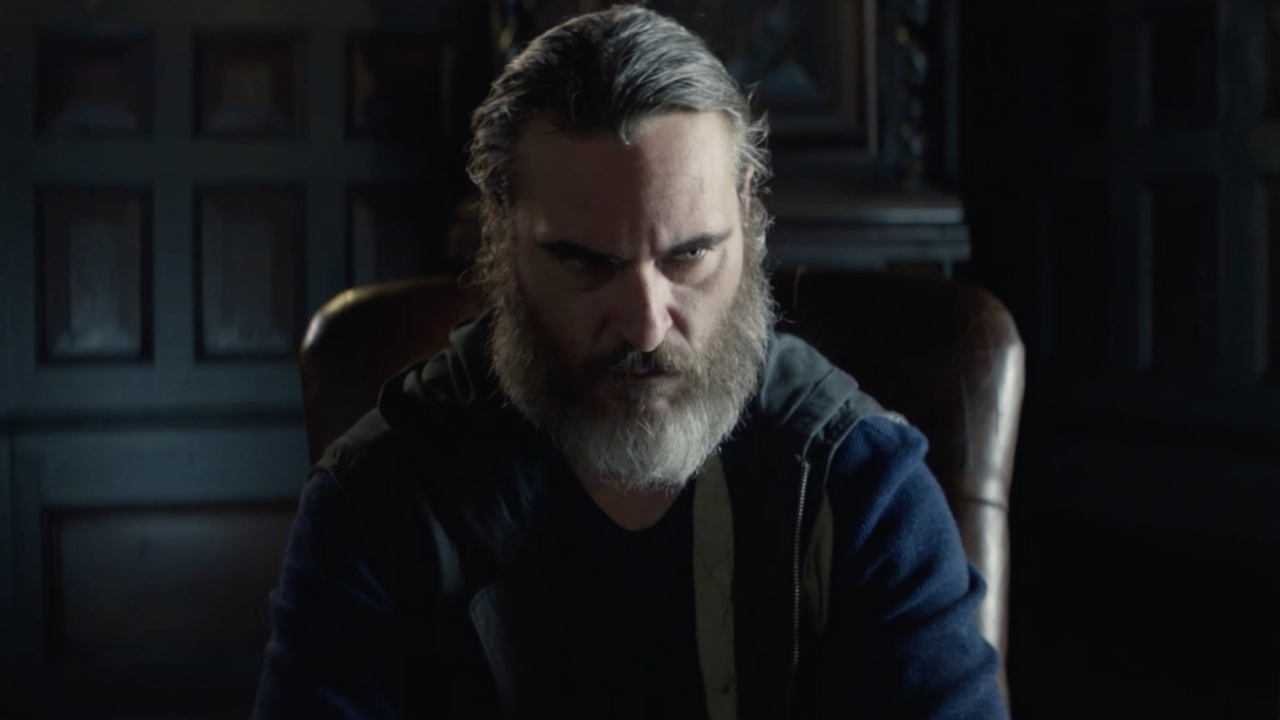
MPAA Rating: R | Rating: ★★★★
Release year: 2018
Genre: Drama, Thriller Director: Lynne Ramsay
Hurt people hurt people. It’s a simplistic phrase, one which brings only a modicum of comfort in its attempts to explain psychological and physical violence inflicted upon persons by others. It’s a much-explored theme in the cinematic genres of horror and thriller, perhaps most popularly exemplified by Alfred Hitchcock’s oeuvre. Hitchcock’s maladjusted male characters, marked by obsession and sociopathic tendencies, are somehow, for all their violent acts, frighteningly tragic figures which engender our sympathies. From Vertigo‘s Scottie to Psycho‘s Norman, these are dangerous and dysfunctional individuals which nevertheless elicit pity. That this latter film is explicitly alluded to in Lynne Ramsay’s You Were Never Really Here feels intentional. Centering on psychologically-shattered military veteran Joe (Joaquin Phoenix), Ramsay’s adaptation of Jonathan Ames’ book is tense and disconcerting, yet richly affecting, even empathetic.
Joe tracks down missing girls for a living, a contract man whose weapon of choice is a weighty ball-peen hammer. The critical comparisons to Scorsese’s Taxi Driver seem a bit simplistic to me, despite both film’s focus on a male veteran engaged in violent vigilante justice. Where Travis Bickle’s decisions are mostly present-tense and external, Joe’s propensity towards justice is clarified in the interior revelations of Joe’s memories. While Bickle is truly a tortured isolated soul operating on his own and with opaque motives, Joe lives with his elderly mother (Judith Roberts), their relationship as one of codependence, a shared history of abuse only hinted at in flashbacks. Travis only finally channels his violent urges towards liberating a young Jodie Foster in the final sequence; Joe saves young girls from sex trafficking because of his mother’s haunting presence, because it’s the right thing to do, at least the right thing for Joe. As he moves like a ghost through urban jungles, grungy hotels, and politicians’ mansions, he carries his hammer like a totem of protection with a stoic look of grim determination. Where some children hold blankets or stuffed animals for comfort, Joe has his hammer.
The sound design and disjointed montage create the perfect unsettling aesthetic for Joe’s fractured psyche, with jump cuts and sudden volume changes keeping the audience in a constant state of tension and dread. One has to do the mental work to discern the key story elements, and even then we’re only privy to brief snapshots in Joe’s memory, intruders from the past forcing their way into the present-day narrative. We see flickers of Joe’s childhood–hiding under tables and beds, screams and violence–and visions of military ops gone horribly wrong, like a truck full of dead bodies. We never learn the whole story behind these images; perhaps Joe doesn’t either. It’s a cinematic PTSD aesthetic, one bolstered by Phoenix’s fully-embodied performance and Ramsay’s keen directorial decisions.
The camera often lingers on Joe’s body and face, his scars and muscles rippling over a hidden, complex interior. In a key climactic moment, one following yet another sequence of hammer-infused violence, Joe strips his shirt off with an anguished desperation in an act of release. Despite this focus on the flesh-and-blood human existence, both the audience and Joe are rarely certain as to whether what we’re seeing is really real in this sense of history and physicality, as opposed to dark visions from Joe’s imagination. If hurt people hurt people, and we’re all broken in some way or another, what hope is there for this violent world? Phoenix also portrayed Jesus in this year’s Mary Magdalene, a similarly physically and emotionally demanding performance where a misunderstood, enigmatic man brings restoration by way of sacrificial action, echoing the words of the prophet Isaiah: by his wounds we are healed.
IMDB Listing: https://www.imdb.com/title/tt5742374/
Leave a Reply